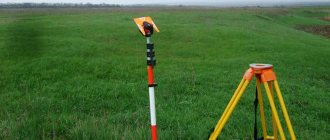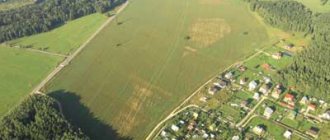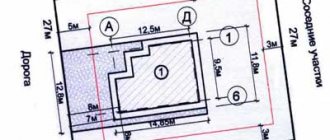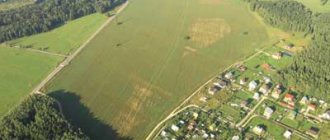Property owners often need to carry out site boundaries. This need arises in the following cases:
- the owner plans to fence the land plot or build a house, garage, or bathhouse on it;
- previously installed boundary signs were destroyed and lost;
- the owner of the plot has changed (it is recommended to install boundary signs in case neighbors are trying to seize part of the land);
- the characteristics of the plot have changed (several plots have been combined or one has been divided into parts)
- disagreements arose with the owners of adjacent storage units.
Control points are fixed on the ground with boundary signs. The owner of the site is responsible for their safety and correct location.
What is it and what is it for?
When conducting registration actions of a separate land plot (allotment), specialists draw up a boundary plan, which indicates the geodetic coordinates of the turning points that define the boundaries of the plot. Determining the location of turning points on a specific area is the procedure for drawing out the boundaries of the site.
Determining the boundaries of the site on the ground is required:
- upon obtaining permission to build a house or other structure. In accordance with the boundaries of the site and the presence/absence of any restrictions (for example, a water protection zone), specialists determine places where a residential building or other structure can be erected and the construction will not harm the environment
- when purchasing a plot. The boundaries are determined so that the owner knows exactly in which places the fence needs to be installed in order to eliminate disputes between neighbors and use his territory with maximum benefit
- when dividing a land plot between owners. The division is required when re-registering plots that are in shared ownership, so that each of the co-owners has the opportunity to use the land, when registering an inheritance, and so on
- in case of loss of land survey signs installed earlier
- if there are errors in the land survey document drawn up earlier
- when developing landscape design and so on
During the work to remove the boundaries of the site at certain (turning) points, specialists install special identification marks (poles, pegs made of reinforcement or other materials, and so on), which cannot be moved or removed independently.
In some cases, the boundaries of a land plot on the ground are defined conditionally. This is largely motivated by the fact that the requirements for mandatory land surveying have now been canceled. Such unauthorized land surveying is easy to challenge. But the absence of boundary signs on the ground can give rise to a number of serious problems and cause long-term litigation. This is especially important when purchasing empty land plots, on which, in addition to boundary signs, there cannot be other coordinates tied to the area.
What it is? Boundary signs Grounds for removal Step-by-step instructions Act of removal in kind Suit in court for restoration Conclusion What is it? Bringing out the boundaries of a land plot in nature is the basis of the process of land surveying, a type of topographic and geodetic services that establish, secure and formalize the boundaries of a plot with boundary signs. As a result of the establishment of boundary signs, the following are revealed: clear boundaries of the site; its reliable area; current location in the general array; form. These parameters are extremely important, since on their basis a general idea of the site emerges, a visual picture is formed that corresponds to the real state of affairs, and information about the characteristics of the site is formed. The lands become legally capable and contextually compliant with the rules provided for conducting property transactions. The origin of the concept is connected with the process being carried out, which consists in transferring the points recorded on paper (in a document, plan) that define the boundaries of the site - into nature, that is, into the real context. Why land surveying is needed - read here. Restoring boundaries To restore boundaries, data on the registration of the site with cadastral registration and extracts from cadastral records are required, on the basis of which preliminary design is carried out in accordance with the information presented in the interactive plan. That is, the necessary information must contain initial documentation about the site in terms of: its characteristic features; configurations; coordinates of turning points; presence and location of corners; total area. After a preliminary analysis of the documentation and topographical location of the site, geodetic work is carried out on the area. This concept is relevant both in land management activities and in urban planning, where it is necessary to accurately verify the territory for the construction of an expensive building. In addition to the designated concept, similar terms can be used: restoration of borders; restoration (installation) of boundary signs. How much does land surveying cost? Read here. Boundary signs Geodetic work by function is not only quite complex and requires high qualifications on the part of the cadastral engineer carrying out the marking of the site. This activity is characterized by a high degree of responsibility - the slightest error in establishing boundary signs can subsequently result in long-term conflicts. In fact, some geodetic companies guarantee an error in establishing boundary markers of no more than 10 centimeters. The marking of the site is carried out directly on the ground. After geodetic surveying, boundary markers are installed in the form of special pegs. This procedure has options: Installation of special standardized stakes with the brand name of the company installing them. Installation of simple wooden pegs. Initial installation of temporary pegs, followed by their replacement with permanent ones reinforced or made of metal pipes. These differences are due not only to the status of the company offering the services, but also to the cost of land in the general area, where lengthy legal disputes can arise for every meter of land. Permanent boundary signs are necessary for setting out boundaries when marking large plots of land, where small pegs can easily get lost. According to standards, boundary signs must be made of durable material and have standard dimensions: length - from 80 centimeters; diameter 5-15 centimeters. To avoid seizure, you can install expensive anti-vandal boundary signs. They are made of metal pipes or angles and are slightly smaller in size than standard ones. Their main advantage is the base dug into the ground, which is made in the shape of an anchor. Accordingly, moving such signs will be more than difficult. Grounds for removal The basis for removal will be the statement of the owner of the site or the realtor preparing the site for sale. Typically, land owners turn to these services when property conflicts arise with neighbors, when preparing cases for litigation, or if errors are identified in the use of the site. There are often cases when construction of a residential building began on a plot acquired by a citizen. After the sale of a nearby plot, the new neighbor (let’s say on the right) carried out the removal of the boundaries of his plot. As a result, it turned out that the owner had seized part of his plot, since the neighbor on the left had stepped beyond his border. To minimize the risks of violating the required standards, the sale of plots must be preceded by determining the actual boundaries of the plot. If a dispute similar to the above example arises, the realtor may not only become the object of serious claims, but also suffer property damage for an improperly conducted transaction. Accordingly, when preparing land for a property transaction, it is necessary to carry out boundary work. How to find out the boundaries of your land plot? Read here. Step-by-step instructions Prepare the documents available for the site. If the restoration of boundaries takes place on an already inhabited site when a dispute arises, then the documents may include from among those available: a cadastral passport; old land surveying; title document for the site. If these documents do not yet exist, prepare the initial act of permission for the land plot for sale (its allocation) and an extract from the cadastral records about its location and all the necessary characteristics. The cadastral engineer, based on the documents presented to him, must adequately navigate the area. Where to contact? You need to contact a geodetic company. But don’t rush to sign an agreement with the first company you come across. Look at several options, call them and have a preliminary conversation with each of the providers of the services offered and choose what suits you best. The conditions for the provision of services in all companies are not the same, and prices also vary greatly. After considering all the proposals and sketching out the main advantages and disadvantages of each of them on paper, decide on your chosen recipient. Once the right choice has been made, contact the company with the documents. After a preliminary conversation and receiving answers to your questions, you can draw up a service agreement. We recommend making a list of questions in advance; it would be a good idea to write them down on paper and review them during the interview process. Keep in mind that you are choosing not just a service provider, but a guarantor of your property security. What is the price? The cost of services for the direct removal of site boundaries is estimated at the cost of the stakes that will determine the corners of your site. For example, in the same region, different companies offered the cost of work at 500 rubles for each driven peg and 1,500 rubles for a similar service. In addition, the more expensive option involved an additional payment for cadastral work in the amount of 200 rubles, and the budget option included their payment in your own expenses. Since there are at least 4 driven stakes, the difference in price is noticeable. In addition, more status (expensive) companies often require an advance payment of up to 70% of the total cost. But the price sometimes affects the quality of the product. More expensive boundary signs were distinguished by their approximate compliance with the standards, while the budget ones had the appearance of ordinary planed branches, which are usually placed as temporary signs, with their subsequent replacement. If the configuration of the site is not geometric in shape, but has an intricate pattern, there will be as many driven pegs as necessary to mark significant protrusions. Naturally, such work is distinguished by the complexity of execution and the corresponding level of cost. As geodetic advertisers write. The deadlines for completing the work are established in a preliminary conversation; you will be told about these conditions immediately. Terms, as well as prices for services, vary greatly among different providers. Usually the work is completed within 10-15 days. Some companies guarantee that work will be completed within a month, and additional payment is provided for urgent work. After the borders are restored in kind, it will take 1-2 days to prepare the act. The work itself can be carried out within 1 day, the rest of the time is necessary to prepare an extract from the State Property Committee. Description of the process The process of restoring borders is carried out after: concluding an agreement; making an advance payment; submission of the required documentation. A cadastral engineer goes to conduct a preliminary survey of a land plot to conduct a geodetic survey and establish marks and notches on the ground for their further securing. While surveyors analyze the data and create a theoretical project, you will have to wait for the appointed day when geodetic work on the area will be carried out. At the appointed time, you will meet with specialists on the land plot and witness the topographic marking of the site. At your representative office, measurements of the site will be taken and its exact area will be determined. On site, experts will determine the correspondences and discrepancies between the real state of affairs and what exists as information set out in accounting records or an old land survey file. The result of the work being carried out will be the restoration of boundary markers in the area. Keep in mind that ideally each boundary marker should be provided with a unique number. All boundary marks are inviolable from third parties. They will be handed over to you against signature and under your personal responsibility. The act of taking out into nature is one of the most important documents as part of the land survey. It represents an unshakable basis for the legal protection of your site. This document is drawn up upon completion of the work, after the installation of pegs at all protruding points that determine the configuration of the land plot, its area and the boundaries drawn along the line of boundary markers. The information described in the act includes: The size of the total area of the site. Its location on the ground, with a description of the exact topographic data. Characteristics and detailed description of the boundaries of the site. Coordinates of each established boundary sign. The act establishes the exact location of each boundary sign. It has its own description and recovery coordinates on the ground. In essence, this document is an act of acceptance and transfer of boundary marks from the cadastral engineer to the owner of the land property. After signing the act, the boundaries of the site will be under your jurisdiction and responsibility. In case of violation of the order established by you at the boundary boundaries, you will defend your property rights in court. Claim in court for restoration The owner has the right to protect the boundaries of his plot in accordance with the provisions of Articles 40-42 of the Land Code of the Russian Federation, as well as on the basis of his constitutional rights. He can protect these rights in court. As a rule, claims to restore the boundaries of a site are filed in the event of a realtor’s mistake when selling a site or if conflicts arise with neighbors. In one of the cases of judicial practice, a realtor brought a family to show the plot and showed the plot for sale with a broad gesture, offering to measure 30 m to the side from the neighbor’s beds and drive a peg. Since there was a river and a road on the other two sides, the site looked quite logical. A meticulous neighbor, whose beds did not reach the end of the plot by 3 meters according to his plan, filed a lawsuit. The case in court was dismissed due to the reconciliation of the parties after the realtor compensated the plaintiff a large sum as moral damages. When using a plot, restoration of boundaries is carried out in the event of disputes with neighbors regarding the rights to use the plots. If you suspect or are convinced that your property rights have been infringed, you can seek justice by filing a claim in the district court where your property is located. statements from here. Before filing a claim, you will need to collect all documents confirming the illegal disposal of your land by your neighbors. Consider the regulations for the use of the site and check whether they are being observed on their part. Invite a cadastral engineer and restore the boundaries of the project. After checking the project information with the real state of affairs, if violations are identified, take an extract confirming the presence of violations. When drawing up a statement of claim, indicate the characteristics of your site and indicate the reason for the emergence of the right to own (use) the site. Next, succinctly and clearly indicate the reason for the claim: What specific violations of your property rights are being carried out. What actions did you take to restore your property rights? What was the defendant’s reaction to the demands presented to him by you? Support each position with the evidence you have or simply list it in detail. Express your claims, which consist of restoring the legal boundaries of your site. In conclusion, provide a list of documents attached as evidence of your correctness, put the date and signature with an explanation of the surname. After your claim is recognized by a court decision, you will be able to restore the violated boundaries.
Who has the right to do it and is it possible to do it yourself?
Cadastral engineers are engaged in delineating the boundaries of a land plot in accordance with the cadastral plan. Organizations of any legal form, including individual entrepreneurs who have a license to perform geodetic work, can act as a specialist.
From a theoretical point of view, work on determining the boundaries of a site can be done independently, having a simple tape measure. However:
- if there is an area of complex geometric shape, special equipment will be required to clarify the coordinates of the object;
- With primary construction and the absence of fences enclosing neighboring areas, it is practically impossible to obtain the coordinates of the reference point without special equipment. All phones and other devices provide a large error in measurements;
- independent removal of boundaries has no legal force and cannot be the basis for further registration actions.
Boundary signs
Geodetic work by function is not only quite complex and requires high qualifications on the part of the cadastral engineer carrying out the marking of the site. This activity is characterized by a high degree of responsibility - the slightest error in establishing boundary signs can subsequently result in long-term conflicts.
In fact, some geodetic companies guarantee an error in establishing boundary markers of no more than 10 centimeters.
The marking of the site is carried out directly on the ground . After geodetic surveying, boundary markers are installed in the form of special pegs. This procedure has options:
- Installation of special standardized stakes with the brand name of the company installing them.
- Installation of simple wooden pegs.
- Initial installation of temporary pegs, followed by their replacement with permanent ones reinforced or made of metal pipes.
These differences are due not only to the status of the company offering the services, but also to the cost of land in the general area, where lengthy legal disputes can arise for every meter of land.
Permanent boundary signs are necessary for setting out boundaries when marking large plots of land, where small pegs can easily get lost.
According to regulations, boundary signs must be made of durable material and have standard dimensions:
- length – from 80 centimeters;
- diameter 5-15 centimeters.
To avoid seizure, you can install expensive anti-vandal boundary signs . They are made of metal pipes or angles and are slightly smaller in size than standard ones. Their main advantage is the base dug into the ground, which is made in the shape of an anchor. Accordingly, moving such signs will be more than difficult.
What is regulated
The procedure for surveying and registering a land plot, including the removal of boundaries in kind, is regulated by:
- Land Code
- Federal Law No. 122, establishing the need and procedure for carrying out the procedure for state registration of land
- Federal Law No. 78, which establishes the need and rules for land surveying, registration of a cadastral plan, and also introduces cadastral engineers
- Federal Law No. 221 “On cadastral activities”
- Government Decree No. 688, which defines the rules for placing the boundaries of a site on the ground
- Methodological recommendations for land surveying developed by the Federal Cadastre Service of the Russian Federation
- Instructions for land surveying, developed and approved by the Russian Federation Committee on Land Management
Coordinates of turning points
The coordinates of the control point, which are actually recorded on the site in the form of established boundary signs, are displayed in a special table on the corresponding site plan. It is worth noting one feature - they cannot be included directly in the cadastral plan - if it is necessary to use such points, you will need to request an extract from the Unified Land Management.
Such an extract is presented in the KV6 form; on the first page of this form the coordinates of the points of interest on the site will be written out. Each of these points is indicated by two coordinates - one of them is displayed along the X-axis, the second along the Y-axis.
Form KV6 from the cadastral extract
It is worth noting that even the available information about what coordinates the PT has, for people who are not specialists in this matter, will not provide much assistance in independently checking or establishing boundaries - such data can only be used by a qualified cadastral engineer.
When determining coordinates, the following actions are performed:
- The position of the contour points is determined directly at the site of their installation. Moreover, each place in which the line ceases to be straight and breaks must be indicated by placing such a point;
- places are marked directly on the ground - often temporary pegs are simply placed on the site;
- replacing temporarily installed pegs with permanent signs that meet established standards and requirements;
- entering marks into accounting documentation;
- carrying out special calculations that make it possible to establish the location of the intersection lines by coordinates at each of the intersection points;
- establishment.
When determining, several existing methods are used:
- geodesic;
- satellite measurement method;
- photogrammetric method;
- cartometry method;
- analytical.
What documents need to be prepared?
To carry out the removal of the boundaries of the land plot, you will need a document that indicates the coordinates of the turning points.
Such documents may be:
- map that is an appendix to the survey file
- cadastral plot plan or cadastral extract
- extract from the Unified State Register of Real Estate
Performers of the operation to determine boundaries prefer to use an extract from the Unified State Register of Real Estate, since this document displays information that is more relevant at a certain point in time. The land survey and cadastral plan data may differ slightly due to changes to the general typographic map.
You can obtain an extract from the real estate register:
- online on the website of the Cadastral Chamber of the Russian Federation
- in person at the regional division of Rosreestr
- through the multifunctional center
The average price of a document in 2021 is 500 rubles.
Cost of work and terms
As a rule, in most surveying companies, the price of removal is determined by the number of points to be fixed on the ground.
For example, showing one point can cost 500-1000 rubles. In different organizations, the price for such work may vary significantly. Most often, survey organizations have a minimum travel amount, which includes marking 5-6 points on the ground. If there are more, payment for each point is added.
Surveying work is easier to perform than other cadastral work and is not as expensive as, for example, primary land surveying.
If you need to carry out urgently, some companies charge an additional fee for this.
As planned, the departure usually takes place within 1-3 days from the date of the order, depending on the flow of clients. Work on the site will also not take much time, on average 1-2 hours. If the site is very large or has many points due to its complex configuration, then field work may take longer.
The removal certificate is prepared within 1-2 weeks after work on the site.
Act of drawing out the boundaries of a land plot (sample)
The procedure for determining turning points on the ground is carried out in 3 stages:
- preparatory , during which documentation is prepared, the timing of the work is agreed upon, and the cost is determined
- field, which consists in determining turning points on the ground and installing boundary signs
- cameral - the final stage, during which a certificate of work performed, technical documentation of the property is prepared and issued to the owner and data is entered into a unified cadastre database
The fact of the removal of the boundaries of the site to the area is confirmed by the relevant act. Currently, several forms of the document are common:
- Simple. The document does not have a specific form. As a rule, it is produced on the letterhead of the company performing the work. The simple act states:
- artist details
- data from the extract from the Unified State Register, which is the basis for the work
- plot dimensions
- exact location (address) of the allotment
- information about the owner of the land
- layout of boundary posts
- allowable error
- With photo report. The document is drawn up for further legal actions, since, unlike the previous form, it has full legal force. The photo report contains:
- an explanatory note indicating the details of the contractor, details of the land plot and its owner, details of the extract about the property, a description of the instruments used for the work
- site plan
- detailed list of turning point coordinates
- photo of boundary posts
- An act with a photo report and a diagram of linking a separate site to the area. The document is supplemented by a diagram on which, in addition to the boundaries of the land plot, all buildings, neighboring plots and other objects are indicated.
Removal bases
The basis for removal will be a statement from the owner of the site or a realtor preparing the site for sale.
Typically, land owners turn to these services when property conflicts arise with neighbors, when preparing cases for litigation, or if errors are identified in the use of the site. There are often cases when construction of a residential building began on a plot acquired by a citizen.
After the sale of a nearby plot, the new neighbor (let’s say on the right) carried out the removal of the boundaries of his plot. As a result, it turned out that the owner had seized part of his plot, since the neighbor on the left had stepped beyond his border.
To minimize the risks of violating the required standards, the sale of plots must be preceded by determining the actual boundaries of the plot. If a dispute similar to the above example arises, the realtor may not only become the object of serious claims, but also suffer property damage for an improperly conducted transaction.
Accordingly, when preparing land for a property transaction, it is necessary to carry out boundary work.
How to find out the boundaries of your land plot? Read here.








